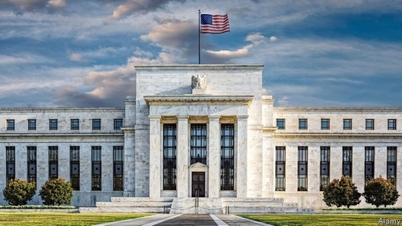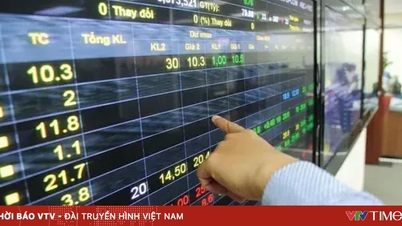
People shop at a supermarket in San Mateo, California, USA. (Photo: THX/TTXVN)
Top advisers to President Donald Trump's administration have warned that the US economy could fall into negative growth in the fourth quarter of 2025 if the federal government shutdown continues, causing severe disruptions in the airline industry and widespread welfare assistance.
Speaking on CBS's Face the Nation on November 9, Kevin Hassett, director of the US National Council of Economic Advisers, said the current government shutdown could cause the US's fourth-quarter GDP (GDP) to decline if the situation is not resolved soon. He said: "Thanksgiving is the busiest time of the year for the US economy. If people cannot travel during this time, we could see a negative growth quarter."
The current US government shutdown has stretched into its 40th day, making it the longest in US history. Hundreds of thousands of federal employees have not been paid, many agencies have been shut down, and food stamps intended to support some 40 million low-income people have been disrupted.
Finance Secretary Scott Bessent warned that the economic impact “will only get worse” as essential services are disrupted. He said staffing shortages at air traffic control towers have forced the Federal Aviation Administration (FAA) to order airlines to cut flights by up to 10% since November 14. Many air traffic controllers have had to take on extra work to make ends meet, while thousands of flights have been canceled.
US Transportation Secretary Sean Duffy also warned that the situation could become chaotic during the Thanksgiving holiday on November 27 - a time when millions of Americans travel. He told Fox News: "Airline operations will be almost paralyzed. There will be very few flights taking off and landing when there are normally thousands of flights a day."
The budget crisis continues to rage on, with Republicans calling for a temporary measure to maintain the current budget, but Democrats are determined to resist without a commitment to repeal the upcoming cuts to the health care credit. Meanwhile, President Trump has been posting on the social media platform Truth Social, criticizing the health insurance system and urging Republicans to eliminate the “filibuster” tactic.
Mr Trump also reiterated his pledge to pay some people $2,000 in direct payments, which he called a 'dividend', to help with medical costs, rather than "letting the money go to insurance companies". This could be funded by tariffs or tax cuts. However, with a wide range of economic activities stalled and the holiday shopping season approaching, experts warn that the damage caused by a prolonged government shutdown could severely impact the US economic growth.
The US Congressional Budget Office (CBO) recently warned that the federal government shutdown will cost the US economy between 7 and 14 billion USD, depending on whether the shutdown lasts another month or not.
CBO Director Phillip Swagel said in a letter to House Budget Committee Chairman Jodey Arrington (R-Texas) that if the government shutdown lasts six weeks, the US economy will lose $11 billion, and if it lasts eight weeks, that number will be $14 billion.
US consumer confidence fell to near a three-and-a-half-year low in early November as many households worried about the economic impact of the prolonged government shutdown, which has caused disruptions ranging from food aid to flight delays.
A survey by the University of Michigan released on November 7 showed that the US Consumer Confidence Index fell to 50.3, the lowest since June 2022, reflecting a “K-shaped” economic picture where high-income households remained stable, while low-income households faced many difficulties.
The US government shutdown due to Congress' failure to pass a new budget bill has forced hundreds of thousands of civil servants to take unpaid leave or work without pay, while reducing food benefits for many households.
The decline in confidence has hit lower-income households hard, while consumer spending remains dominated by higher-income households. About 40% of U.S. consumer spending is driven by the top 20% of households, bolstered by a strong stock market, reflecting the growing divide in the U.S. economy.
In another worrying sign for the US economy, the country's manufacturing sector continued to decline in October 2025, marking the eighth consecutive month of decline, as new orders remained low and suppliers' deliveries were delayed amid rising import tariffs.
The latest survey from the Institute for Supply Management (ISM) shows a bleak picture for the manufacturing sector, which President Trump hopes will be stimulated by tariffs. However, economists say that returning US manufacturing to its former glory is unlikely due to structural problems, especially the shortage of skilled workers.
Source: https://vtv.vn/kinh-te-my-co-nguy-co-tang-truong-am-100251110153305646.htm


![[Photo] Prime Minister Pham Minh Chinh attends the Patriotic Emulation Congress of the Ministry of Foreign Affairs for the 2025-2030 period](https://vphoto.vietnam.vn/thumb/1200x675/vietnam/resource/IMAGE/2025/11/10/1762762603245_dsc-1428-jpg.webp)


![[Photo] Prime Minister Pham Minh Chinh attends the annual Vietnam Business Forum](https://vphoto.vietnam.vn/thumb/1200x675/vietnam/resource/IMAGE/2025/11/10/1762780307172_dsc-1710-jpg.webp)




























































































![Dong Nai OCOP transition: [Article 3] Linking tourism with OCOP product consumption](https://vphoto.vietnam.vn/thumb/402x226/vietnam/resource/IMAGE/2025/11/10/1762739199309_1324-2740-7_n-162543_981.jpeg)










Comment (0)